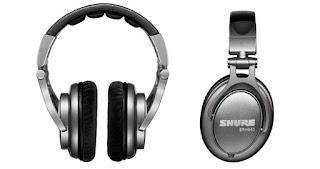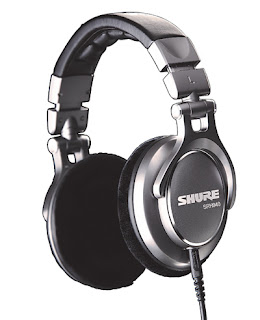The construction arrangement means that the cups exert slightly more pressure on and around the ear than some phones, but they are well padded and comfortable enough for long listening sessions, and this pressure ensures that isolation from external sounds is pretty good. For me, the only suggestion of discomfort came from the top band, which has a tendency to load the entire weight of the phones onto a small point on top of the head instead of spreading it out, but I suspect that has as much to do with the shape of my head as with the design of these phones. With an impedance rated at 42Ω and a sensitivity of 100dB SPL/mW, the SRH-940s shouldn't require any sort of esoteric headphone amp to drive them.
 |
| Shure SRH-940 Headphones |
Shure SRH940: Sound quality. The first thing that strikes us about the SRH940s is their immediate fidelity.
They’re a fast, energetic listening session, and open and revealing with it too – which goes slightly against the grain of their closed-back DNA. The rich synths of the track are conveyed explicitly, and there’s oodles of detail in the low-fi hi-hat part.
The mellow melody is nicely rounded, and the whole frequency range sits together really well, with nothing standing out too far or sitting too far back in the mix.
Shure SRH940: Verdict
Cons? Only a minor one: there’s a very slight spike near the top of the treble, which can occasionally stray into thinness during lean-sounding recordings, but it’s not a deal-breaker by any means.
Various adjectives come to mind to describe the sound preciseness of the SRH-940's, among them 'beat', 'crystal clear' and 'well-projected'. They seem to have a broad lift in the mid‑range, from perhaps 1‑3 kHz, which brings out the snarl of an electric guitar or the ring of a snare drum without over-emphasising sibilants or making crash cymbals leap out of the mix. They're perfect for rock music, or indeed anything else where the main focus is mid‑range impact and excitement. Transients are well represented, and the high frequencies seem balanced.
If there's a down side, it's that the bass is arguably a bit too tight. Whenever I turned to electronica, or indeed any mix that leaned on a heavy bottom end, I was struck with a gut feeling that something was lacking. It's not that bass and low mids are absent or inaccurate; rather, they are slightly overshadowed by that prominent mid range, in a way that sometimes robs them of 'oomph'. If you like bass to be an emotional experience, these are not the phones for you.
 |
| Shure SRH-940 |
The SRH-940 will play at reasonable volume levels with portable devices such as most cellphones, iPods and so on. The straight cord feels strong enough to withstand some abuse, and with the earcups pulled all the way down and rotated against my chest, I can have the headphone around my neck all day long without it getting in my way when I'm not listening to it. It also comes with a coiled cord. Neither cord has an angled plug unfortunately. The other good news with the cord is that it's detachable. The other less-than-good news is that the detachable end is partially proprietary. The detachable plug is a standard sub-mini plug (next size smaller than a 1/8 inch mini-plug), but the plastic fitting behind that plug locks into the jack on the earcup in a way that would require DIY'ers to take the earcup apart if they want to use a different cable without the proprietary connector.
The earcups of the SRH-940 completely surround my ears, and it's a close fit. The internal space for ears in each oval earcup measure 2-5/8 by 1-7/8 inches. I find the fit very comfortable, but people with much larger ears may feel very cramped. The carrycase that comes with the SRH-940 is fairly large, and would take up a lot of space in a carry-on bag for airline travel. If this is your situation, I'd recommend carrying the SRH-940 around your neck when boarding, or just wrap it in something thin to place in a suitcase, to give it minimal protection. The entire headphone seems to be plastic except for the velour earpads, and Made In China means they optimized the SRH-940 for lowest production cost. The good news is that it seems to be very well made, and given the sound quality, a real bargain at the usual prices. Isolation from external sounds is good even when not playing music. When playing music, I can't hear the telephone ring from 3 feet away, and the ringer is the old-fashioned kind - very attention-getting.
The SRH-940 have an extended high-frequency response with incredible detail - so much so that upon first listen, you might think their response puts too much emphasis on the highs. For example, one of my colleagues commented that the SRH-940 were too sibilant when he first listened to them. On the contrary, I feel that the high-frequency response is actually exceedingly smooth. Yes, there is a small bit of high-frequency lift to my ears, but it's a very smooth rise, and to me, what I hear is the opposite of sibilance. There isn't any harshness in the 7-12 kHz range, which is where I find the most offensive energy in regards to sibilance. Moreover, the SRH-940's midrange is as neutral as any headphone I've ever heard. Vocals, for example, translate well between the SRH-940 and various listening-environment and speaker combinations throughout my studio and home - in terms of both relative level in the mix and harmonic content.
Compared to the Sennheiser HD800, which up until now were my favorite studio headphones, the SRH940 actually have less sizzle at the very top end, but the SRH-940's upper mids are a little more prevalent. The gentle lift in the HD800's lower mids isn't there in the SRH-940, so if you're using the Shure headphones for mixing, you might not try so hard to clean up what "muddiness" might be in your recording. And perhaps because of the more clinical-sounding lower mids and upper lows, the SRH-940 seem to exhibit less bass in general during casual listening, but the extreme lows are definitely there when you are listening critically, with a tightness that is astounding. With that said, I think that listeners who are accustomed to an overabundance of bass volume in their cans will definitely find the SRH-940 inappropriate for their needs, but I find the low-frequency clarity refreshing. Plus, transient response throughout is amazing.
The SRH940 come with a semi-rigid, multi-compartment carrying case that's too large for carry-on air travel, but it does protect the headphones well. The SRH-940 have hinges in all the expected locations, and they can fold up asymmetrically such that one earcup backs into the other (as opposed to the earcups facing each other). Once collapsed, they take up as much room as any other full-size folding headphones, but one advantage to this asymmetric arrangement is that there's less likelihood for pressure on the cable where it exits from the earcup. Speaking of the cable, you'll find two in the case - one straight and one coiled. Thankfully, the straight cable is just the right length for working at a console; you'll need to extend it if you plan to hand these headphones to a guitarist during tracking. The cables lock into the left earcup with a twist. You'll also find a second pair of velour ear cushions in the case.
The headphones are surprisingly light, and they're comfortable for extending wearing. The only caveat worth mentioning is that I found that the orientation of the SRH-940 on my head had a greater effect on the sound than with other headphones. For example, I can hear the bass levels go up when I rotate the earcups a bit so that the headband is just above my forehead - in fact, I get the most neutral-sounding response with the headphones positioned this way. Also, if I take off my glasses, the ear cushions seal better, and again, I get better bass response.
That said, we all know that reproducing sound to give maximum enjoyment is a very different business from reproducing it in a way that is useful to the mix engineer. And for most studio purposes, I think the frequency balance of these phones, with its ruthless absence of hype at the low end, is much more a blessing than a curse. Most mixes stand or fall on the mid-range, and you quickly appreciate the detail and clarity that these phones bring to that region. After a lot of listening, I even began to feel that my beloved Sony's V-150 were sounding muddy and veiled by comparison. I wouldn't want to make dubstep on these, but for any sort of guitar‑based music, they're hard to beat, and the good levels of comfort and isolation make them ideal for tracking as well as mixing.
No comments:
Post a Comment